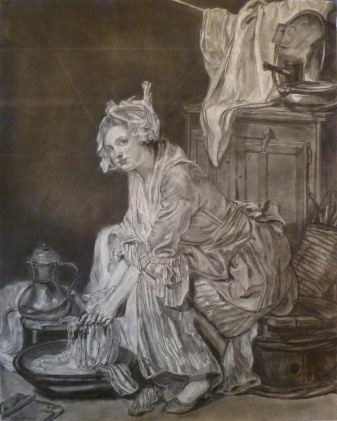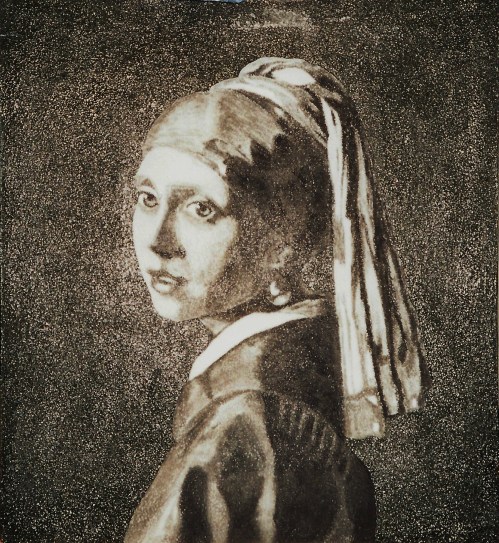Artserious–a linguistic invention–so, it’s time to get artserious, begin at the beginning, and learn the classical academic painting process alluded to in this prior post.
As the Dalai Lama says, “Know the rules well so you can learn to break them effectively.” This is probably one of the most important reasons to have classical training and, although it is best received in person, teacher-student, I hope to help you through some of the same processes online that I teach my private students. (If you are in the Phoenix Metro and want one-on-one lessons, contact me through this blog.)
In coming weeks, I will discuss the following: materials, design, compositional unity, applying the Golden Mean, Munsell’s color system and hue, value, and intensity, seven basic color schemes, aerial perspective, the cartoon, accurate enlargement/graphing and transferring to panel, gessoing masonite board, inking the drawing, sculpting with gesso for bas relief, the charcoal study, underpainting, mixing a flesh palette, and colored oil glazes.
It is a lengthy syllabus, but I hope you will profit from the instruction in some way.
Creating fine art is very much a science; therefore, you should come to this training with an open mind and put your previous painting experience on hold for awhile so that you can see with fresh eyes. This is not quick art, but I promise you that with proper instruction and following the process outlined, along with self-discipline, persistence, and patience, you can achieve the high degree of quality in your painting you have hoped for. It is better to spend weeks on one excellent painting that can be considered significant art, than to spend a couple of hurried days on a piece that will end up in the trash.
Keep in mind there are preliminaries we will skip for now and come back to later, as I am sure you want to get to the actual creation of a portrait. Beginning with how to get an accurate drawing, our ultimate purpose here is to get an excellent likeness and end up with a high quality, Renaissance-style classical academic painting that will never find itself in a garage sale. You will be copying an Old Master oil portrait of your choice–you can paint family AFTER you have learned the basics and “mastered the Masters.”
Your first assignment: Choose an Old Master portrait that you love. Keep the goal in mind; you are learning the process here, so you will want to choose a picture that is not too complex, has clearly delineated eyes, nose, mouth, hair, clothing, and a simpler background.
I will be using Vermeer’s Girl with a Pearl Earring.
Make sure your reference is very high resolution, and high quality. Two superb online sources are the Getty Museum or Art Renewal Center. You should never undermine your efforts by beginning with inferior reference, as I have seen students who, despite admonition, try this and give up in frustration.
Print the reference on glossy photo paper, as it shows detail much better than other surfaces. Print one in grayscale and one in color, ledger size if possible, otherwise 8 1/2″ x 11″. You can put them on a flash drive or CD and have it printed at FedX or any print shop. It is helpful to save the references on your computer desktop as well, for quick access. I use my computer to enlarge certain small areas as I go along and need to get a closer look. The computer, however, will not replace your printouts in this process.
Some Masters to consider for our purposes are (in no particular order): Titian, Caravaggio, Rubens, Rembrandt, Velasquez, David, Vermeer, Gerome, Godward, Leighton, Alma-Tadema, and Bouguereau are all excellent artists from which to learn, although there are so many more.

Jean Leon Gerome, Black Bashi-bazouk, 1869, 26×32″

Titian, Flora, 1515
Here are the materials you will need for the process:
Oil Painting Materials:
references
pens/pencils
extra-fine permanent markers(Sharpies), black, blue, green, red
acetate
General’s charcoal pencils
vine charcoal
blending stumps (tortillions)
metal yardstick
metal 18” ruler
transparent triangle, 18”
kneaded eraser
India ink and liner sable brush
spray workable fixative
Exacto knife
clear tape
artist’s white tape
Golden acrylic matte medium
Masonite or hardwood board
sandpaper very rough #40-60, very smooth #100-200
natural sponge
Knox Gelatin
paint roller for application of gesso
retouch varnish
Liquin
turpentine for brush cleaning
olive oil for brushes, cleaning hands, oiling palette
leak proof turpentine container
easel
plastic wrap
blue paper towels
mahl stick
notebook
palette knives
Brushes:
bright sable #2, 4, 10
flat bristle #2, 4, 10
round sable #1, 8
round bristle #0, 8
mongoose flat #6
mongoose round #0
mongoose filbert #4, 8
Paint:
*titanium white
*flake white
ivory black
mars black
chromium oxide green
pthalo blue
cadmium yellow light
yellow ochre
raw sienna
raw umber
cadmium orange
burnt sienna
burnt umber
cadmium red light
alizarin crimson permanent
cobalt violet
ultramarine violet
French ultramarine blue
cobalt blue
cerulean blue
viridian green
Shiva cadmium green
Grumbacher pthalo yellow green
Winsor and Newton Winsor orange
Indian yellow
napthol red light
*Avoid zinc white (PW4) whenever possible. It is often added to paint colors one would not suspect, such as in titanium white, lead white, and to various other colors to render them more transparent. It is also used as a filler to make them less expensive to manufacture. Zinc white can make your paintings crack, according to extensive, lengthy studies done with conservators at the National Gallery of Art, Washington.
Also, buy the best quality paint you can afford, as student grade and many professional grades contain excessive aluminum stearate that causes darkening of the paint film over time. Good commercial brands include professional grades of Utrecht, Williamsburg (both made in the U.S.), Old Holland (Netherlands), and Sennelier (France). I like the unique textures of handmade paints as well, and buy from colormen like Robert Doak, Michael Harding, and Natural Pigments.
*marble-inclusive gesso
*values palette
*homemade medium
In the next post, we’ll discuss supports, marble-inclusive gesso, and the 9-value (+black and white) palette you will need.
































